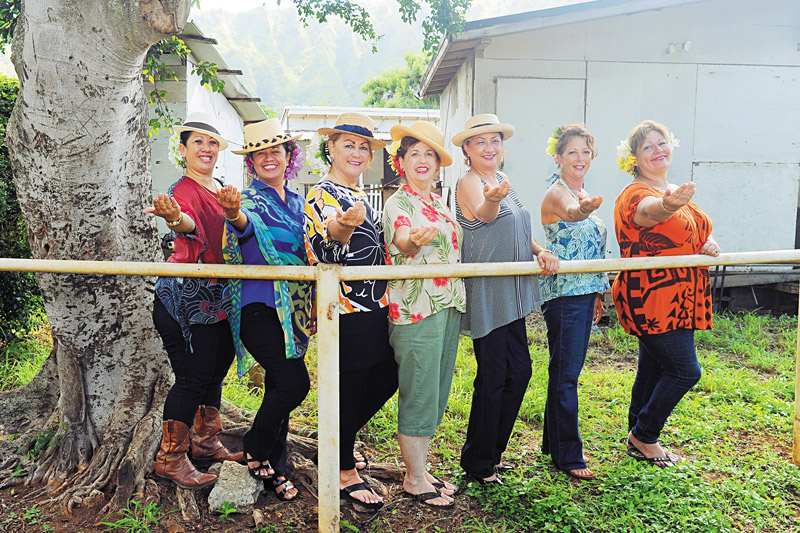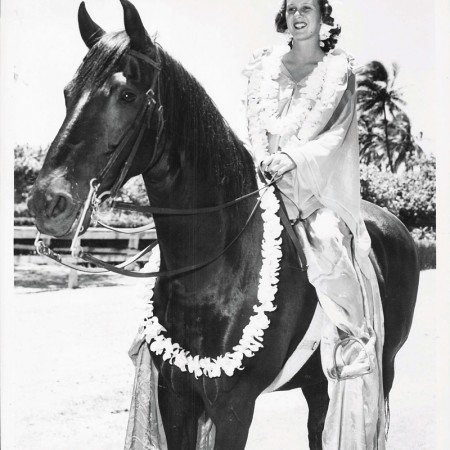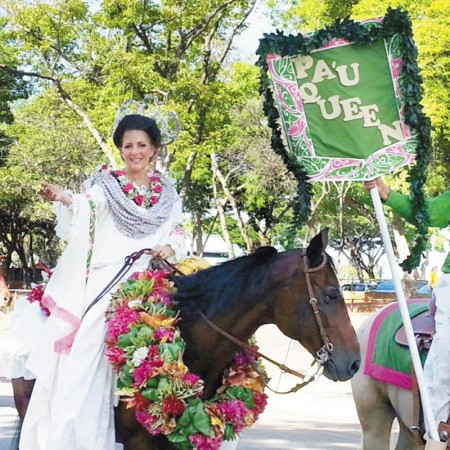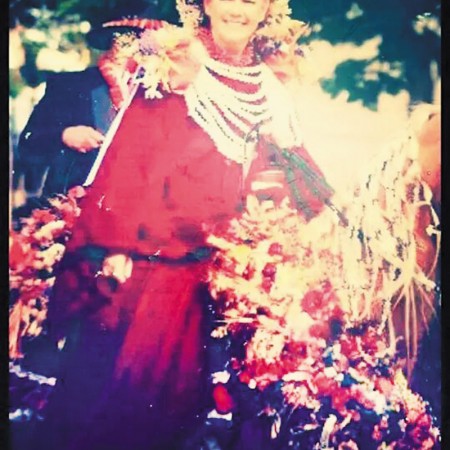We sit down with former Aloha Festivals pa‘u queens

Former Aloha Festivals pa’u queens (from left): Leiala Cook, Kahikulani Whitted, Luka Ramos, Bonnie Neal, Beverly Lee, Terry Dinubilo-Murray and Roxanne Kalilimoku
‘MidWeek’ sits down with former Aloha Festivals pa‘u queens, a proud Hawaiian tradition that goes back to Queen Liliuokalani
He wahine holo lio `oe la Malama o Kina`u lio la You are a lady who likes to ride
On the horse named Kina`u —Wahine Holo Lio-Chant for Queen Emma
Lest we forget that Hawaii was once a kingdom, there is pageantry at Aloha Festivals each September to regale us in royalty. Staged on floral floats or equestrian units, the splendor of Hawaii’s monarchy period parades before us. This is no Disneyesque revue. It is our homage to revered island tradition and cultural consciousness that easily can fade with public indifference.
Will we keep this tradition alive or let it ride off into the sunset?
We are especially reminded of that quest by pa‘u (pah-oo) riders, women on horseback adorned in long, colorful skirts or Hawaiian pa‘u.
Pa‘u queens of the past gathered at Cook’s Ranch in Waimanalo on a recent Sunday afternoon to talk about their storied roles. These are dedicated women, many endowed by family legacies to perpetuate a treasured part of Hawaiian history and pageantry.
They are as gracious and poised in real life as they are in full regalia on a horse.
- Pa‘u riders and horses weren’t so heavily garlanded back in 1951 when Ginger Charlock was queen of the Kamehameha Day Parade STAR-ADVERTISER PHOTO
- Terri Dinubilo wearing a 100-strand crown flower lei in 2012
- Roxanne Kalilimoku in 2013 and Luka Ramos in 2004 CONTRIBUTED PHOTOS
It occurs to us that pa`u queens are royalty with the shortest reigns on record. Having the top spot in the Hawaiian equestrian procession, their official appearances and reign on the reins lasts for three hours during a parade through Waikiki.
Ah, but it is a glorious and memorable ride that stirs the soul.
“Once you’re on the horse, there’s no other feeling like it,” says Beverly Lee (2008 pa`u queen). “You ride with pride, extending aloha to everyone from keiki to kupuna on the sidelines.”
“My fondest memory was wearing a 100-strand crown flower lei,” recalls Terri Dinubilo (2012). “Crown flowers have royal symbolism. They were Queen Liliuokalani’s favorite, and it was special to make that connection.”
“This experience is not just for me,” reflects Roxanne Kalilimoku (2013). “It’s for the community at large to embrace as a way to perpetuate our culture. We have to keep this custom alive because the parade is the biggest showcase of tradition we have in Hawaii.”
That sense of decorum and duty is taken seriously by each of the past queens. Earning their way to lead the contingent of pa`u riders and
eight island princess units is a trail of commitment.
“It’s not just a matter of dressing and getting on a horse,” says Kahikulani Balles-Whitted (2006). “That might be the impression we give because of the glamour with which we present ourselves in the parade, but for months leading up to the parade we are immersed in intense preparation and practice to perfect what we do.”
“Each participant makes a commitment to the time, expense and responsibility involved,” says Luka Ramos (2004), whose brother Boyd R. Prince II and mother Luka Kaaiahua-Prince inspired her pa`u interest.
The personal expense per event is about $2,000 per person for horse and wardrobe. None of the equestrian activities is financed by public or private sources.
“But we love it, so we continue doing it,” says Ramos, whose pure-Hawaiian mother was a pa`u princess.
Ramos has been in 35 parades, and at one time led one of the largest equestrian units with 22 riders.
There will be 72 pa‘u riders in the parade Saturday (Sept. 26), starting at 9 a.m. from Ala Moana Park and ending at Kapiolani Park. Eight past pa‘u queens, who include singer Melveen Leed, will be part of one of the largest equestrian representations to date.
The 3-and-a-half-mile parade route attracts a million spectators every year, including television audiences.
Camera-toting tourists share sunlit vantage points with local residents, who become cultural guides on the spot.
For the benefit of those sidewalk ambassadors, here are pa`u facts at a glance:
Horses were introduced to Hawaii in 1803. Hawaiian men and women took to riding, establishing an equestrian tradition that includes the paniolo, Hawaiian cowboy.
Lady riders wore pa`u or long skirts to protect their legs and outfits while traveling.
Nine to 12 yards of fabric is wrapped around the rider and held in place by six or eight kukui nuts twisted inside the fabric.
Riders train for years to master their craft. They are skilled in horsemanship, as well as display beauty, personality, elegance and aloha.
Horses are shod, groomed and drilled in parade maneuvers. Elaborate haku (woven) lei of as many as 40 bundles of foliage and flowers are draped over the mane and rump.
Eight island units are led by pa‘u princesses dressed in colors and flowers representing Oahu, Hawaii, Kauai, Maui, Molokai, Lanai, Niihau and Kahoolawe.
Someone who knows the pa‘u history and tradition well is Leiala Cook, daughter of John and the late Lita Cook of Waimanalo. Her parents founded Hawaii Pa‘u Riders in 1981 when then-Gov. George Ariyoshi invited riders to participate in the Madison Square Garden Horse Show and Veterans Day parade in New York.
Since then, Hawaii’s colorful units have appeared in 36 parades on the Mainland and one in Belgium.
Cook, this year’s equestrian chairwoman, lives, breathes and extols the pa‘u tradition under the watchful eye of her 86-year-old mentor and father.
“It takes a lot of time and dedication,” she emphasizes. “Everything is done by volunteers, including the gathering of foliage and flowers for lei. It’s six months of sacrifice, being away from family to focus on preparations.”
Parade participants are meticulously groomed beginning the night before the parade. There are baths, hair brushing and braiding, riding gear placement, elaborate haku lei adornments and safe transport to the starting point.
And that’s just the horses. The ladies are tended to by hair, makeup and wardrobe stylists, as well as by members of her riding unit, who fuss until every detail is picture-perfect.
Everyone from riders to pooper-scoopers is judged before and during the parade. Winning units are recognized at an awards ceremony the day after the parade at Cook’s Ranch in Waimanalo. The celebratory occasion is a fitting climax to Aloha Festivals, the only statewide cultural event in the nation.
Bonnie Neal, this year’s pa‘u queen, gives us the crowning comment.
“To be in this position now as queen and have these lovely past queens with me is indeed an honor,” she says. “It’s difficult to describe the emotions I felt when asked to be queen this year. It’s very emotional for a non-Hawaiian who’s Hawaiian at heart.
“We are grateful to the people who come out to see us. You can feel the aloha. You can’t help but smile!”
OAHU ALOHA FESTIVAL 2015 HERITAGE:
Aloha Festivals was first held in 1946 as Aloha Week, a celebration of Hawaiian culture, integrating traditions and cultures of the islands through music, dance, cuisine and art.
Theme: “Hulu Aloha—Beloved Feather Treasures”
Parade: 69th annual Floral Parade. Saturday, Sept. 26, at 9 a.m. from Ala Moana Park down Kalakaua Avenue to Kapiolani Park.
Info: alohafestivals.com. Phone: 923-2030. Hawaii Pa`u Riders, hawaiipauriders.org. Phone: 561-6580.









